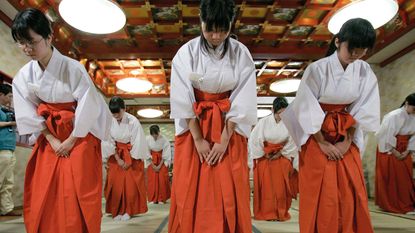Why investors can’t afford to ignore Japanese stocks
Japan boasts the broadest market outside the US, replete with cash-rich, resilient companies that have battled their way through 30 years of deflation, says Merryn Somerset Webb. And it hasn’t been this cheap in years.


Earlier this year it looked as though Japan was having a very good pandemic indeed. Cases had been low. Total deaths were under 2,000, in a country with a population double the size of ours. In April Prime Minister Shinzo Abe announced that this is the result of Japanese exceptionalism – the result of doing things in a “characteristically Japanese way”. His deputy went a little further. The success, he said, was about Japan’s mindo (a not very easily translatable term that refers to the quality of a group of people) being tip-top.
Other suggestions centred around Japan’s very low level of co-morbidities – very little obesity and hence very few type-two diabetics, for example; the fact that the Japanese rarely entertain in their own houses (most interaction is in bars and restaurants outside the home); the existence of local health centres originally set up to track and trace tuberculosis sufferers; the cultural traditions that mean the Japanese rarely touch each other; and finally the prevalence of the tuberculosis vaccine, which is thought to provide some kind of immunity.
The problem? It turns out exceptionalism is less common than one might think. Cases are now ticking up in Japan. Its first two waves were bumps on the graph, but it is now seeing a seven-day rolling average of over 3,000 cases a day, while deaths are nearing 3,000. This is a miserable example (although it is worth noting that, like most east Asian countries, Japan is still doing wildly better than any countries in the West).
Subscribe to MoneyWeek
Subscribe to MoneyWeek today and get your first six magazine issues absolutely FREE

Sign up to Money Morning
Don't miss the latest investment and personal finances news, market analysis, plus money-saving tips with our free twice-daily newsletter
Don't miss the latest investment and personal finances news, market analysis, plus money-saving tips with our free twice-daily newsletter
But it should perhaps serve as a reminder that while lots of things about Japan are different and interesting, it isn’t, as the newly retired Japan strategist Jonathan Allum says, “uniquely unique” (listen to our podcast at moneyweek.com for more from Allum). That, says Allum, is something that more investors should recognise. Too many shun Japanese equities, or if they don’t ignore them completely, they consider stockpicking in Japan “problematic” and “index their Japanese portfolios even while running the rest of the world actively”.
The market’s breadth is unrivalled outside the US
The first of these things is definitely a mistake – and the second probably is too. Japan’s stockmarket has a “breadth that is unrivalled outside the US”. It is home to some of the world’s most important companies. And its stock of listed companies “is replenished by more than 80 initial public offerings (IPOs) every year” – at a time when many Western stockmarkets are shrinking. It has an increasingly shareholder-friendly bias after many years in which you could have suggested it was taking the idea of stakeholder capitalism to an unwelcome extreme.
Its company reports are no longer impenetrable and its larger firms “employ slick investor-relations departments” and (pre-Covid-19 at least) tour the world to meet foreign investors. There’s more good news. Its companies are in very good shape. Peter Tasker of Arcus Investment points out that of the few companies in the world that are over 200 years old, 55% are in Japan. They must, he says, be “doing something right” (for more from Peter go to moneyweek.com and listen to our podcast with him). There is no way that any that aren’t could have survived the last 30 years. The deflationary environment in place since the crash of 1989 has forced continued cost-efficiency on the corporate world and bred a fondness for cash not seen anywhere else. If the post-pandemic investing buzzword is to be “resilience”, Japan should be the market everyone is heading for.
Its listed companies went into this crisis with the biggest cash reserves ever recorded: around $6.5trn in cash and short-term securities on their balance sheets, says Jesper Koll, an adviser to Wisdom Tree Investments, in the Financial Times. That formed a “war chest” worth some 130% of GDP and one that is nicely spread around the market: in May 54% of Japanese companies had a cash pile worth more than their shareholders’ equity. In the US the ratio is less than a third of that and what cash there is, is jammed into the already too-full pockets of the big tech firms.
This matters. Japan’s cash provides a buffer against the rolling disasters that appear to make up the modern world and could mean that there is a wave of mergers and acquisitions ahead. That’s something that is usually good for markets, particularly ones as fragmented as Japan’s. Look out for activity in the car-parts, insurance, chemicals and base-metals sectors, says Koll. But it also means that Japan can guarantee investors something they really want: income.
The payout ratio has long been pretty low (up to 35% of net profits). But it has been creeping up and is now around 60%, thanks to a rise in both dividends and share buybacks, which were very rare in Japan until five years ago. Buybacks have fallen back a bit this year amid the uncertainty, but the overall market comes with a dividend yield of around 2.5%. Add in the buyback expected next year, says Tasker, and you are looking at a total dividend and buyback return of around 4%. What kind of fool would ignore that in a negative interest-rate world?
A geared play on global growth
There are two other reasons to be invested in the Japanese market in general. The first is that it does, as many of those who invest in it passively believe, often move with the global economy. Global growth up, Nikkei 225 up. That makes sense, given quite how outward facing this market is.
That’s not just because it is the world’s third-largest economy (and a nice example of how a smallish island can operate a massive economy without ceding sovereignty to a giant neighbour). It is also because the market has a considerably higher exposure to cyclical sectors such as vehicles and financials than most, while Japan’s large companies also have fingers in many other nation’s pies. Sales from overseas affiliates are worth around 60% of GDP, says Tasker.
One example: Fast Retailing (owner of Uniqlo) might appear to have a shop on every corner in Tokyo, but it still generates more of its sales and profits in China than in Japan. The point? If the global economy recovers sharply next year (as the vaccine leads to normalisation of activity), so will the Japanese stockmarket. Japanese analysts tend to be conservative when making forecasts, notes Nikko Asset Management, and corporate managements “upon which sell-side analysts highly rely, can get in legal trouble if they guide earnings too optimistically”. So if the global economy surprises on the upside as post-lockdown pent-up demand is unleashed, as we think it will, then Japanese corporate profits should also surprise on the upside.
In the bargain basement
The next reason for international investors to give up their incessant Japan-bashing is valuations. Even before the rise in earnings you might expect in 2021, Japan is remarkably cheap. There is the yield mentioned above. But beyond that, says Tasker, price/earnings (p/e) ratios are still at the kind of levels “I have rarely seen in my rather long career”. There has been a big run-up in the Nikkei since 2012, but the average price-to-book (p/b) ratio across the market has barely budged.
That tells you the run-up has not been about expanding multiples, but about rising earnings. Japan now trades on a cyclically adjusted p/e ratio (Cape) of round 19, compared with a historical average of 23 (the US figures are 30 and 25 respectively) and a p/b ratio of 1.3 (close to its historical average). In there, says Tasker, are value opportunities of an “extreme nature”.
This all sounds good – and might explain why Japan is already in the midst of something of a stealth bull market. The Nikkei rose by 15% in November alone and is now flirting with 27,000. That’s some way off its peak of 38, 915 in 1989 (it fell by 40% in 1990 and another 26% in 1992), but nonetheless represents a fairly splendid recovery from the lows of 2011, when it hit 8,295. In fact, say the analysts at Gavekal, if you knock out the consistently underperforming financials, Japanese equity markets have had a “very honourable past decade”.
The Daiwa All Listed Non Financials Index is up by well over 70% since 2010. There are risks in Japan just as everywhere else (more Covid-19 nightmares, currency fluctuations, too much debt and so on), but in most of the areas that matter to investors it looks good. Going into 2021, says Gavekal, it is going to thrive, just “unbeknownst to most investors”.
What to buy now
So if Japan is going to thrive how can your portfolio thrive alongside it? How about looking at what Warren Buffett is up to? In August he invested $6bn (real money) in five of Japan’s big sogo shosha, one-time commodity trading firms that are, as the FT puts it, “increasingly transforming into global venture capital and private-equity businesses”. Berkshire Hathaway is now one of the top shareholders (5%-plus) in Mitsubishi Corp. (Tokyo: 8058), Mitsui & Co. (Tokyo: 8031), Sumitomo Corp. (Tokyo: 8053), Marubeni Corp. (Tokyo: 8002) and Itochu Corp. (Tokyo: 8001). This all makes perfect sense. They are inflation hedges and heavily leveraged to global growth, but also cheap and plugged into the success of the domestic economy – including the unlisted companies where much of the growth is. They should benefit from the cyclical reopening trade. Otherwise the Baillie Gifford Japan Trust (LSE: BGFD) is a great way to get general exposure to Japanese growth.
The Lindsell Train Japanese Equity Fund offers a more focused portfolio of high-quality companies; the Baillie Gifford Shin Nippon trust (LSE: BGS) gets you into smaller growth companies (I am on the board of this trust so do not take this as a recommendation!). Income seekers should consider the JP Morgan Japan Small Cap Growth and Income Trust (LSE: JSGI) and the CC Japan Income and Growth Trust (LSE: CCJI).
Those interested in value (as we all should be!) might turn to the AVI Japan Opportunity Trust (LSE: AJOT), which seeks to take advantage of changing corporate-governance trends in Japan, and the Man GLG Japan CoreAlpha Fund. The latter has had a disappointing 2020. But if the global rotation from growth to value investing gathers some steam, it may have a better 2
Merryn Somerset Webb started her career in Tokyo at public broadcaster NHK before becoming a Japanese equity broker at what was then Warburgs. She went on to work at SBC and UBS without moving from her desk in Kamiyacho (it was the age of mergers).
After five years in Japan she returned to work in the UK at Paribas. This soon became BNP Paribas. Again, no desk move was required. On leaving the City, Merryn helped The Week magazine with its City pages before becoming the launch editor of MoneyWeek in 2000 and taking on columns first in the Sunday Times and then in 2009 in the Financial Times
Twenty years on, MoneyWeek is the best-selling financial magazine in the UK. Merryn was its Editor in Chief until 2022. She is now a senior columnist at Bloomberg and host of the Merryn Talks Money podcast - but still writes for Moneyweek monthly.
Merryn is also is a non executive director of two investment trusts – BlackRock Throgmorton, and the Murray Income Investment Trust.
-
 Coventry Building Society bids £780m for Co-operative Bank - what could it mean for customers?
Coventry Building Society bids £780m for Co-operative Bank - what could it mean for customers?Coventry Building Society has put in an offer of £780 million to buy Co-operative Bank. When will the potential deal happen and what could it mean for customers?
By Vaishali Varu Published
-
 Review: Three magnificent Beachcomber resorts in Mauritius
Review: Three magnificent Beachcomber resorts in MauritiusMoneyWeek Travel Ruth Emery explores the Indian Ocean island from Beachcomber resorts Shandrani, Trou aux Biches and Paradis
By Ruth Emery Published
-
 The industry at the heart of global technology
The industry at the heart of global technologyThe semiconductor industry powers key trends such as artificial intelligence, says Rupert Hargreaves
By Rupert Hargreaves Published
-
 Three emerging Asian markets to invest in
Three emerging Asian markets to invest inProfessional investor Chetan Sehgal of Templeton Emerging Markets Investment Trust tells us where he’d put his money
By Chetan Sehgal Published
-
 What to consider before investing in small-cap indexes
What to consider before investing in small-cap indexesSmall-cap index trackers show why your choice of benchmark can make a large difference to long-term returns
By Cris Sholto Heaton Published
-
 Why space investments are the way to go for investors
Why space investments are the way to go for investorsSpace investments will change our world beyond recognition, UK investors should take note
By Merryn Somerset Webb Published
-
 Time to tap into Africa’s mobile money boom
Time to tap into Africa’s mobile money boomFavourable demographics have put Africa on the path to growth when it comes to mobile money and digital banking
By Rupert Hargreaves Published
-
 M&S is back in fashion: but how long can this success last?
M&S is back in fashion: but how long can this success last?M&S has exceeded expectations in the past few years, but can it keep up the momentum?
By Rupert Hargreaves Published
-
 The end of China’s boom
The end of China’s boomLike the US, China too got fat on fake money. Now, China's doom is not far away.
By Bill Bonner Published
-
 Magic mushrooms — an investment boom or doom?
Magic mushrooms — an investment boom or doom?Investing in these promising medical developments might see you embark on the trip of a lifetime.
By Bruce Packard Published